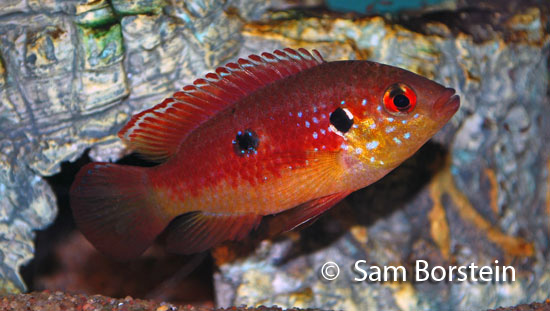Hemichromis sp. "moanda"

Above: A female Hemichromis sp. "moanda" in breeding color. Photo by Sam Borstein.
Etymology:
Genus- Hemi= half (Greek), chromis= a fish, perhaps a perch (Greek).
Species-moanda= named afte the location point Moanda.
Intro:
Hemichromis sp. "moanda" is an undescribed Jewel Cichlid from the Congo Region. This species in the last few years has gained lots of popularity in the hobby. This is most likely attributed to this species outstanding cherry red dorsal color and yellow belly as well as its mild demeanor in comparison to other members of the genus.
Dr. Anton Lamboj believes that Hemichromis sp. "moanda" may actually correspond to the type specimens of Hemichromis lifalili, thus being the true Hemichromis lifalili. A revision of the genus is in the work and we shall soon find out where this species stands taxonomically.
Distribution:
Hemichromis sp. "moanda" is found through the Lower Congo River drainage.
Size, Maturity, and Sexual Dimorphism:
Size: Males- 4 inches, Females- 3 inches
Maturity: 2.5 inches
Sexual Dimorphism: Males are larger than the females and have more blue spangaling. Females tend to be stronger in their red and yellow coloration.
Care:
Hemichromis sp. "moanda" is not a very difficult species to keep. What makes keeping this species a little easier in comparison to other Hemichromis is that this species is not very aggressive. A well bonded pair can be kept in a 20 long tank, but a 40 breeder would be more ideal. This species is fairly tollerant of water parameters, but the extremes should be avoided.
A tank housing Hemichromis sp. "moanda" should be decorated with plenty of rock and driftwood as hiding spots. It's also advisable to place some caves in the tank for potential breeding spots.
Diet:
I fed a variety of foods such as fish Dainichi Veggie Deluxe, Tetra Cichlid Sticks, and New Life Spectrum and the fish thrived.
Breeding:
Hemichromis sp. "moanda" is a cave spawner and very easy to breed. This very fertile fish can spawn about every two weeks or so. Typically, the pair will stake out a cave and defend it before spawning and intensify in color. When this fish is spawning it is stunning. The red coloration becomes extremely strong and the yellow color in the belly becomes quite noticeable and bright. Females will lay anywhere from 100-250 cherry red eggs. These hatch in about 4 days. The larvae are closely guarded by the adults and occasionally moved into pits in the substrate. The larvae wriggle for about 4-5 days and are then free swimming.
The parents are vigilant defenders of their fry, which are fairly small. The fry are easy to raise and feed. Once free swimming the fry are small enough to take baby brine shrimp. I've found the easiest way to raise the fry is leaving them with the pair for the first month. They will raise the fry until they are around a half inch long. At this point, I like to remove the fry and raise them in a separate aquarium.
Conclusion:
Hemichromis sp. "moanda" is a wonderful and highly colorful species. This is a great species for any West African cichlid lover and even New World cichlid keepers as the behavior is very similar to some of the American cichlids. This is an ideal Jewel cichlid for a new comer into the West African cichlid hobby as it is easy to keep and fairly peaceful compared to other members of the genus.
